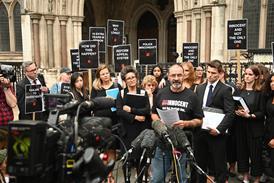Both Katie Hopkins and Jack Monroe are outspoken, including on Twitter. During anti-government protests following the 2015 general election, graffiti was sprayed on to a memorial to the women of the second world war. Hopkins tweeted at 7.20pm on 18 May: ‘@MsJackMonroe scrawled on any memorials recently? Vandalised the memory of those who fought for your freedom. Grandma got any more medals?’ Monroe responded 13 minutes later: ‘I have NEVER “scrawled on a memorial”. Brother in the RAF. Dad was a Para in the Falklands. You’re a piece of shit’. Later that evening she demanded Hopkins delete the tweet, apologise and make a £5,000 donation to charity. By 9.47pm, Hopkins, having realised she had confused Monroe with journalist Laurie Penny, had deleted the first tweet but further tweeted: ‘Can someone explain to me – in 10 words or less – the difference between irritant @PennyRed and social anthrax @MsJackMonroe.’ On 2 June, Hopkins finally tweeted a retraction, but no apology: ‘@MsJackMonroe I was confused about identity. I got it wrong.’
There have been many defamation cases involving social media, including Twitter (McAlpine v Bercow [2013]). But this is the first judgment to grapple in detail with how to apply the requirement to prove serious harm, as required by the Defamation Act 2013, to what the judge described as the ‘dynamic and interactive’ conversational world of Twitter.
Hopkins’ case was that her tweets meant no more than that Monroe supported, politically, the vandals and that this had not caused her serious harm.
The judge found that the tweets, in context, conveyed the meaning that Monroe ‘condoned and approved of the… vandalisation by obscene graffiti of the women’s war memorial in Whitehall, a monument to those who fought for her freedom’; and that given that spraying graffiti on public monuments is a criminal offence, and reasonable thinking members of society generally would strongly disapprove of anyone who approved or condoned it, this was defamatory.
On the extent of publication of the tweets, Hopkins’ deletion of the first tweet meant that the statistical tools of Twitter Analytics were unavailable. But by using the figures for other tweets and the visits to Hopkins’ home page in May 2015 (5.7m), the judge estimated that at around 20,000 readers for the first tweet and 100,000 for the second.
In relation to serious harm, Warby J was prepared to infer serious harm to Monroe’s reputation by inference, ‘on the straightforward basis that the tweets complained of have a tendency to cause harm to this claimant’s reputation in the eyes of third parties, of a kind that would be serious for her’. He nevertheless addressed Hopkins’ arguments on harm, stating that:
(i) A tweet can (like a broadcast) have significant impact notwithstanding its transience.
(ii) A reader would not discount the allegation simply because it was made by Hopkins, on Twitter.
(iii) It will be difficult for a claimant to gather evidence of harm, and absence of evidence does not mean no serious harm has occurred. In any event these were abusive tweets.
(iv) The fact that someone is pre-disposed (for example, because of the political standpoint) to hold a bad opinion of someone does not mean that their views cannot be hardened – ‘if someone is hated for their sexuality or their left-wing views, that does not mean they cannot be libelled by being accused of condoning the vandalisation of a war memorial. It can add to the list of reasons to revile her’.
(v) Monroe’s own denials would not have much mitigated the harm caused, a denial is not the same as a correction, retraction or apology, and Monroe had no access on Twitter to Hopkins’ followers.
The overall ceiling for general damages in defamation is about £300,000. Here the judge awarded £16,000 for the 7.20pm tweet and £8,000 for the 9.47pm tweet, for harm which he described as serious but not grave. He would have awarded less, but for Hopkins’ conduct in failing to apologise. Monroe apparently has a CFA with a success fee, and Hopkins has already been ordered to pay £107,000 towards her costs, estimated to exceed £300,000.
Warby J’s decision does suggest that, while the claimant has to prove as a fact on the balance of probabilities that serious harm has been caused by, or is likely to result from, the publication complained of, the bar for serious harm is not very high. In one of the first cases, Cooke and Midland Heart v MGN [2014], Bean J had appeared to suggest, to the alarm of some, that only if a mass circulation newspaper wrongly accused someone of being a terrorist or a paedophile could the likelihood of serious harm to reputation be inferred without the claimant adducing evidence of actual harm. Subsequent decisions have made clear that serious harm may be inferred in respect of lesser allegations, recognising the evidential difficulties for an individual seeking to prove such harm – see Lachaux v Independent Print and others [2015] (newspaper allegations that the UAE-based claimant was a wife-beater who had lied about and kidnapped their son); Theedom v Nourish Training [2015] (email to clients stating that a former employee had been dismissed for gross misconduct); and Prince Moulay v Elaph Publishing [2017] (publication on website for one day of allegation that the prince was plotting against his cousin the King of Morocco).
However, there are caveats: there must be some evidence from which the court can infer serious harm, from witness evidence, online activity and the like (which the defendant will be wise to call evidence to rebut – Hopkins did not give evidence); evidence of harm to the claimant’s feelings will not be relevant (although it may aggravate damages, or assist in an action under the Data Protection Act 1998); there may be causation issues, for example if the allegations have also been published by others (Sobrinho v Impresa Publishing SA [2016]); a prompt apology or vindication in a regulatory or public inquiry may undo the harm (Cooke, Sobrinho); a body trading for profit will need to provide convincing evidence that the publication has caused, or is likely to cause, serious financial loss (Down to Earth (London) Ltd v London Borough of Harrow [2016], the restaurant’s accounts were inadequate to demonstrate that a partially inaccurate council press release had caused serious loss of profit), although even here the court may be prepared to infer such loss (Brett Wilson LLP v Person(s) Unknown [2015], operating the solicitorsfromhell.com website, at least one client appeared to have been deterred from instructing the firm).
Hopkins has said that she will seek permission to appeal on the grounds that there was no actual evidence of serious harm. The serious harm test is already being considered by the Court of Appeal in Lachaux (judgment awaited). While context is crucial, an argument that Twitter users ignore Twitter as a news source seems destined to fail. A Reuters Institute study last year found that in the UK 20% of under-35s used Twitter weekly for news (41% used Facebook), notwithstanding strong public broadcasters and national press. Did Warby J make sufficient allowance for free speech? He accepted that ‘the demands of pluralism in a democratic society make it important to allow room for differing views to be expressed, without fear of paying damages for defamation’. As Sedley LJ said in Redmond-Bate v DPP [2000]: ‘Freedom only to speak inoffensively is not worth having.’ However, even Twitter’s own rules recognise that there are limits. Hopkins’ conduct may not have been harassing or hateful conduct, grossly offensive or discriminatory, but she made a serious error. A prompt and unequivocal apology would have been sensible, despite the loss of face.
The disproportionate level of costs in defamation cases with CFAs is already before the court in Flood v Times Newspapers Ltd (judgment of the Supreme Court awaited) and BNM v MGN (due in the Court of Appeal in October), but if Hopkins was on a CFA she may struggle to challenge her opponent’s CFA.
Rupert Earle is a partner and head of media litigation at Bates Wells Braithwaite. Andrew Wheelhouse, a senior paralegal at the firm, also contributed to this article





























No comments yet